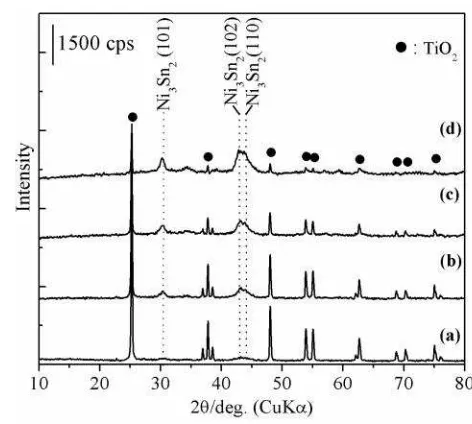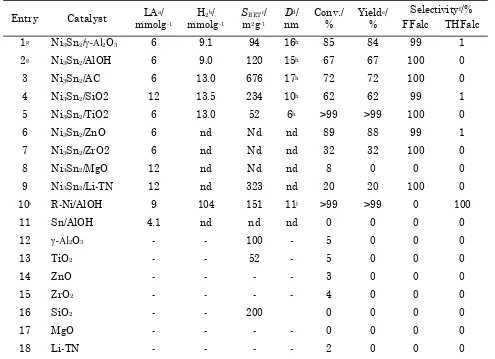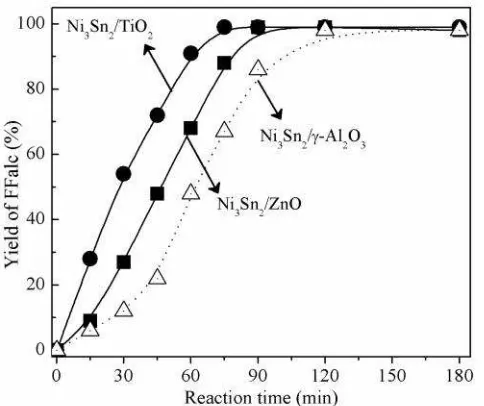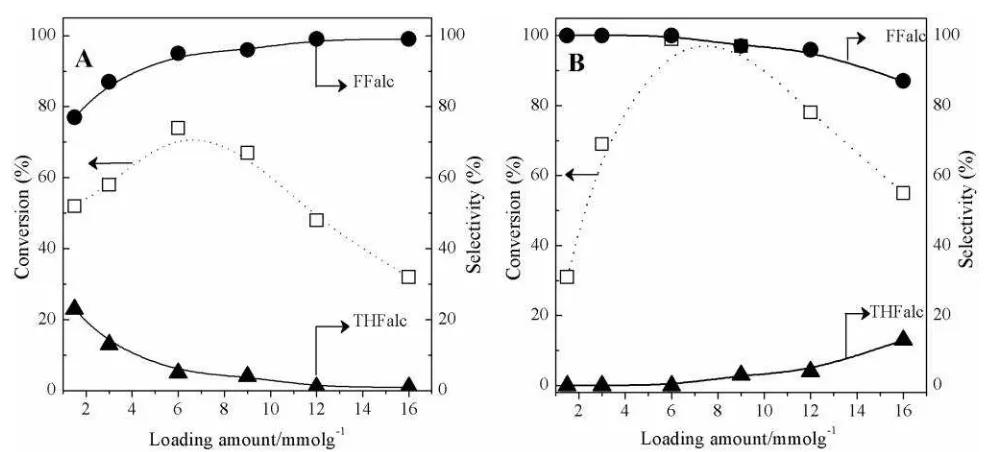Selective Hydrogenation of Biomass-derived Furfural
over Supported Ni
3Sn
2Alloy: Role of Supports
R. Rodiansono1*, Maria Dewi Astuti1, Syahrul Khairi2, Shogo Shimazu3
1Department of Chemistry, Lambung Mangkurat University, Banjarbaru,
South Kalimantan, Indonesia 70713
2Department of Chemical Engineering, Tanjung Pura University, Pontianak,
West Kalimantan, Indonesia
3Graduate School of Engineering, Chiba University, 1-33 Yayoi, Inage, Chiba 263-8522, Japan Bulletin of Chemical Reaction Engineering & Catalysis, 11 (1), 2016, 1-9
Abstract
A highly active and selective hydrogenation of biomass-derived furfural into furfuryl alcohol was achieved using supported single phase Ni3Sn2 alloy catalysts. Various supports such as active carbon (AC), -Al2O3, Al(OH)3, ZnO, TiO2, ZrO2, MgO, Li-TN, and SiO2 have been employed in order to under-stand the role of the support on the formation of Ni3Sn2 alloy phase and its catalytic performance. Sup-ported Ni3Sn2 alloy catalysts were synthesised via a simple hydrothermal treatment of the mixture of aqueous solution of nickel chloride hexahydrate and ethanol solution of tin(II) chloride dihydrate in presence of ethylene glycol at 423 K for 24 h followed by H2 treatment at 673 K for 1.5 h, then charac-terised by using ICP-AES, XRD, H2- and N2-adsorption. XRD profiles of samples showed that the Ni3Sn2 alloy phases are readily formed during hydrothermal processes and become clearly observed at 2 = 43-44o after H2 treatment. The presence of Ni3Sn2 alloy species that dispersed on the supports is believed to play a key role in highly active and selective hydrogenation of biomass-derived furfural to-wards furfuryl alcohol. Ni3Sn2 on TiO2 and ZnO supports exhibited much lower reaction temperature to achieved >99% yield of furfuryl alcohol product compared with other supports. The effects of loading amount of Ni-Sn, reaction conditions (temperature and time profile) on the activity and selectivity to-wards the desired product are systematically discussed. Copyright © 2016 BCREC GROUP. All rights reserved
Keywords: selective hydrogenation; furfural; furfuryl alcohol; supported Ni3Sn2 alloy catalysts
How to Cite: Rodiansono, R., Astuti, M.D., Khairi, S., Shimazu, S. (2016). Selective Hydrogenation of Biomass-derived Furfural over Supported Ni3Sn2 Alloy: Role of Supports. Bulletin of Chemical
Reac-tion Engineering & Catalysis, 11 (1): 1-9. (doi:10.9767/bcrec.11.1.393.1-9)
Permalink/DOI: http://dx.doi.org/10.9767/bcrec.11.1.393.1-9
Available online at BCREC Website: http://bcrec.undip.ac.id
Research Article
1. Introduction
Selective hydrogenation of furfural (FFald) to furfuryl alcohol (FFalc) is great industrial in-terest since it widely use in various
applica-tions [1]. Industrially, furfuryl alcohol was pro-duced by liquid hydrogenation of furfural at the high temperature and H2 pressure by using copper-chromite (Cu-Cr) catalysts which exhib-its moderate in activity and selectivity. The main drawbacks of this catalyst system are tox-icity and unrecyclable due to generated Cr2O3 and severe leaching of the metal into product * Corresponding Author.
E-mail: [email protected] (R. Rodiansono)
[2, 3]. Therefore, several attempts have been reported in order to replace Cu-Cr catalysts or to develop a new metallic catalyst system which have more efficient catalytic process and less severe of environmental problem.
Among developed metal catalysts, nickel-based catalyst with metal co-promotor or modi-fied supports has been studied intensively due to its high activity for hydrogenation both of C=C and C=O. Several metal co-promotors were applied to nickel such as Cu [4, 5], Fe, Ce [6, 7], and Sn [8] in order to improve its chemoselectivity towards C=O rather than to C=C. In this advantage, system based on Ni modified with Fe, Ce or heteropolyacids have been proved to be successful, reaching 98% se-lectivity to FFalc at almost total conversion [4-8]. However, in some cases these modified complete reaction [9]. Moreover, the employing of noble metal catalyst is less favorable in eco-nomical advantageous. Therefore, the design less expensive the active and selective catalyst system for production furfuryl alcohol is an is-sue of interest, which still presents great chal-lenges.
We have reported the preparation of Ni-Sn alloy catalysts supported on various inorganic compounds such as Al2O3, aluminium hydrox-ide (AlOH), active carbon (AC), SiO2, and TiO2. The supported Ni-Sn alloy catalysts were pre-pared via the hydrothermal treatment of a so-lution that contained Ni and Sn species at 423 K for 24 h followed by H2 treatment at 573-873 K for 90 min. We found that the catalyst that consisted of Ni-Sn alloy (as Ni3Sn2 species) dis-persed on TiO2 allowed a remarkable reduction of the reaction temperature to 383 K. Our pre-vious results have shown that the high conver-sion of FFald and the high selectivity of FFalc was achieved over Ni-Sn(1.5)/TiO2 catalyst that can be attributed to the relatively high disper-sion of Ni-Sn alloy on TiO2 giving rise to active sites with a significantly higher catalytic activ-ity [10]. The formation of Ni3Sn2 or Ni3Sn alloy phases after H2 treatment of Ni-Sn alloy cata-lysts supported on aluminium hydroxide are believed to play a key role in the enhancement of the chemoselectivity [11, 12].
In the present report, we have extended our study to the investigation of catalytic behaviour of Ni3Sn2 alloy catalysts supported on various inorganic compounds, such as: Al2O3,
alumin-ium hydroxide (AlOH), active carbon (AC), ZnO, SiO2, Li-taeniolite (Li-TN), MgO, ZrO2, and TiO2. The supported Ni-Sn alloy catalysts were prepared with similar way to our previous report [10]. The catalytic performance of the synthesised catalysts was evaluated selective hydrogenation of biomass-derived furfural (FFald) to furfuryl alcohol (FFalc) and tetrahy-drofurfuryl alcohol (THFalc). chased from Japan Aerosil Co. Li-taeniolite (Li-TN) was donated by Kunimine Industries Co. Ltd. Furfural, furfuryl alcohol, tetrahydrofur-furyl alcohol, iso-propanol, ethanol were pur-chased from Tokyo Chemical Industries Co. (TCI). All organic chemical compounds were purified using standard procedures prior to use.
2.2. Catalyst preparation
A typical procedure of the synthesis of g-Al2O3 supported Ni-Sn (1.5 feeding ratio) alloy catalyst is described as follows [10]. NiCl2.6H2O (7.2 mmol) was dissolved in deionised water (denoted as solution A), and SnCl2.2H2O (4.8 mmol) was dissolved in ethanol/2-methoxy ethanol (2:1) (denoted as solution B) at room temperature. Solutions A, B, and -Al2O3 (1 g) were mixed at room temperature; the tempera-ture was subsequently raised to 323 K and the mixture was stirred for 12 h. The pH of the mixture was adjusted to 12 through the drop-wise addition of an aqueous solution of NaOH (3.1 M). The mixture was then placed into a sealed-Teflon autoclave for the hydrothermal reaction at 423 K for 24 h. The resulting black precipitate was filtered, washed with distilled water, and then dried under vacuum overnight. Prior to the catalytic reaction, the obtained black powder was treated under hydrogen at 673 K for 90 min. A similar procedure was also applied for the synthesis of supported Ni-Sn(1.5) alloy on SiO2, ZrO2, ZnO, MgO, and Li-TN.
2.3. Characterisations
Gas chromatography (GC) analyses were performed on a Shimadzu GC-8A equipped with a flame ionisation detector and with Ther-mon 3000 and Silicone OV-101 packing. GC-MS was performed on a Shimadzu GC-17B equipped with a thermal conductivity detector and with an RT- DEXsm capillary column. 1Hand 13C NMR spectra were obtained on a JNM-AL400 spectrometer at 400 MHz; samples for NMR were dissolved in chloroform-d1 with TMS as an internal standard. Products were confirmed by the comparison of their GC reten-tion time, mass, 1H and 13C NMR spectra with those of authentic samples. XRD measure-ments were recorded on a Mac Science M18XHF instrument using monochromatic CuK radiation (λ= 0.15418 nm). The XRD was operated at 40 kV and 200 mA with a step width of 0.02o and a scan speed of 4o min-1 ( 1 = 0.154057 nm, 2 = 0.154433 nm). ICP measure-ments were performed on an SPS 1800H plasma spectrometer of Seiko Instruments Inc. (Ni: 221.7162 nm and Sn: 189.898 nm).
The BET surface area (SBET) and pore vol-ume (Vp) were measured using N2 physisorp-tion at 77 K on a Belsorp Max (BEL Japan). The samples were degassed at 473 K for 2 h to remove physisorbed gases prior to the measure-ment. The amount of nitrogen adsorbed onto the samples was used to calculate the BET sur-face area via the BET equation. The pore vol-ume was estimated to be the liquid volvol-ume of nitrogen at a relative pressure of approxi-mately 0.995 according to the Barrett–Joyner– Halenda (BJH) approach based on desorption data [13]. SEM images of the synthesised cata-lysts were taken on a JEOL JSM-610SEM after the samples were coated using a JEOL JTC-1600 autofine coater.
The H2 uptake was determined through ir-reversible H2 chemisorption. After the catalyst was heated at 393 K under vacuum for 30 min, it was treated at 673 K under H2 for 30 min. The catalysts were subsequently cooled to room temperature under vacuum for 30 min. The H2 measurement was conducted at 273 K, and H2 uptake was calculated according to the method described in the literature [14]
2.4. Typical procedure for hydrogenation of furfural
Catalyst (0.05 g), FFald (1.1 mmol), and iso-PrOH (3 mL) as solvent were placed into a glass reaction tube, which fitted inside a stainless steel reactor. After H2 was introduced into the reactor with an initial H2 pressure of
3.0 MPa at room temperature, the temperature of the reactor was increased to 383 K. After 75 min, the conversion of FFald and the yield of FFalc were determined via GC analysis. The Ni3Sn2/-Al2O3 catalyst was easily separated using either simple centrifugation or filtration. The solvent was removed in vacuo, and the residue was purified via silica-gel column chro-matography.
3. Results and Discussion
3.1. Catalyst characterisation
Ten types of supports (carbon (AC), -Al2O3, Al(OH)3, ZnO, ZrO2, MgO, Li-TN, TiO2, and SiO2) were employed for the preparation of the supported Ni3Sn2 alloy catalysts and the phys-icochemical properties of the supported Ni3Sn2 alloy catalysts have been reported previously [10]. Among of the selected supports, we high-phase at 2 =43-44 o become intensified with the increase of the loading amount of Ni-Sn (Figure 1a-d). The crystallite sizes of Ni3Sn2(101) in Ni3Sn2(110) diffraction peaks, respectively (Figure 2a-d). These results suggest that the higher dispersions of Ni-Sn alloy on the TiO2 were formed as roughly depicted in the average Ni3Sn2(101) crystallite sizes (Table 1).
phases as well as at 2 of 30.8o for Ni3Sn2(101) phase (Figure 3b-e).
The catalytic reaction results of each the synthesized supported Ni3Sn2 alloy in the hy-drogenation of biomass-derived furfural into furfuryl alcohol are summarized in Table 1. For catalysts supported on Al2O3, AlOH, SiO2, and AC, relatively high FFald conversions and yields of FFalc were obtained (Table 1, entries 1-4). For the Ni3Sn2/-Al2O3 catalyst, FFald con-version was 85% with a FFalc yield of 84% (Table 1, entry 1), whereas the Ni3Sn2/AlOH,
Ni3Sn2/AC, and Ni3Sn2/SiO2 catalysts produced FFalc yields of 67%, 72%, and 62%, respectively (Table 1, entries 2-4). A remarkably high FFald conversion (>99%) and FFalc selectivity (100%) were obtained when Ni3Sn2/TiO2 was used un-der the same conditions (Table 1, entry 5). The high conversion of FFald and the high selectiv-ity of FFalc over Ni3Sn2/TiO2 can be attributed to the relatively high dispersion of Ni-Sn alloy on TiO2 giving rise to active sites with a signifi-cantly higher catalytic activity. Alternatively, the high conversion and selectivity may be a re-sult of the strong interactions between the ac-tive metals and TiO2 generating significant in-teractions between C=O groups and Ni-TiOx sites and leading to high selectivity to unsatu-rated alcohols [15]. As comparison, Kijenski et al. have reported that Pt catalysts supported on TiO2 gave higher selectivity to FFalc in the hy-drogenation of FFald than did Pt supported on SiO2, ZrO2 or MgO [16]. Our results also showed that Ni3Sn2 alloy catalysts supported on ZrO2, MgO, and Li-TN only gave 32%, 0%, and 20% yield of FFalc, respectively (Table 1, entries 7, 8, and 9). In the case of Ni3Sn2 supported on ZnO, the conversion of FFald was 89% with selectiv-ity of FFalc and THFalc of 99% and 1%, respec-tively (entry 6). Recently, Corma et al. studied the chemoselectivity of Ni supported on TiO2 in the hydrogenation of substituted nitro aromatics [17]. Moreover, the monometallic R-Ni/AlOH catalyst converted FFald to give >99% THFalc, which indicates that R-Ni/AlOH hydrogenated both C=C and C=O of FFald (entry 10), whereas Bulletin of Chemical Reaction Engineering & Catalysis, 11(1), 2016, 4
Figure 1. XRD patterns of supported Ni3Sn2 on -Al2O3 with different loading amount of (a) 4 mmol, (b) 8 mmol, (c) 12 mmol, and (d) 16 mmol.
Figure 2. XRD patterns of supported Ni3Sn2 on TiO2 with different loading amount of (a) 4 mmol, (b) 8 mmol, (c) 12 mmol, and (d) 16 mmol.
Bulletin of Chemical Reaction Engineering & Catalysis, 11(1), 2016, 5
Sn/AlOH was not active for the hydrogenation of FFald under the same conditions (entry 11). These results suggest that the addition of tin to form Ni-Sn allsoy retards the C=C hydrogena-tion activity of nickel. Swift et al. have reported that the formation of a Ni-Sn alloy by the addi-tion of tin to a Ni/SiO2 catalyst remarkably changed the reactivity of Ni/SiO2 because of the change in the electron density of nickel metal [18]. Delbecq et al. indicated that the C=O hy-drogenation selectivity in the hyhy-drogenation of
, -unsaturated aldehydes could be enhanced
by the formation of a Pt-Sn alloy because of the higher affinity of the alloy towards C=O rather than towards C=C bonds, as noted pre-viously [19]. Resasco et al. have reported that the selective hydrogenation of C=O versus C=C in , -unsaturated aldehydes by Pd-Cu alloy supported on silica was caused by the preferential 2-coordination of C=O to Pd [20]. In addition, the catalytic reaction over sup-ports (carbon (AC), -Al2O3, Al(OH)3, ZnO, ZrO2, MgO, Li-TN, TiO2, and SiO2) was also carried out under the same reaction
condi-Table 1. Comparison of catalytic activity of various supported Ni3Sn2 alloy catalysts for selective hy-drogenation of biomass-derived furfural
Entry Catalyst LAa/ mmolg-1
H2b/ mmolg-1
SBETc/ m2g-1
Dd/ nm
Conv./ %
Yielde/ %
Selectivityf/% FFalc THFalc
1g Ni3Sn2/-Al2O3 6 9.1 94 16h 85 84 99 1
2g Ni3Sn2/AlOH 6 9.0 120 15h 67 67 100 0
3 Ni3Sn2/AC 6 13.0 676 17h 72 72 100 0
4 Ni3Sn2/SiO2 12 13.5 234 10h 62 62 99 1
5 Ni3Sn2/TiO2 6 13.0 52 6h >99 >99 100 0
6 Ni3Sn2/ZnO 6 nd Nd nd 89 88 99 1
7 Ni3Sn2/ZrO2 6 nd Nd nd 32 32 100 0
8 Ni3Sn2/MgO 12 nd Nd nd 8 0 0 0
9 Ni3Sn2/Li-TN 12 nd 323 nd 20 20 100 0
10i R-Ni/AlOH 9 104 151 11j >99 >99 0 100
11 Sn/AlOH 4.1 nd nd nd 0 0 0 0
12 -Al2O3 - - 100 - 5 0 0 0
13 TiO2 - - 52 - 5 0 0 0
14 ZnO - - - - 3 0 0 0
15 ZrO2 - - - - 4 0 0 0
16 SiO2 - - 200 0 0 0 0
17 MgO - - - - 0 0 0 0
18 Li-TN - - - - 2 0 0 0
Bulletin of Chemical Reaction Engineering & Catalysis, 11(1), 2016, 6
tions. The conversion of FFald was around 2-5% without the formation either FFalc or THFalc (entries 12-18) indicating the main ac-tive site of the catalysts (Ni3Sn2 alloy species) plays important role in the activity and selec-tivity.
In order to get insight into the role of sup-port, the catalytic performance of three types of supported Ni3Sn2/TiO2, Ni3Sn2/ZnO, and Ni3Sn2/-Al2O3 alloy catalysts have been evalu-ated at different reaction temperature, time profile, and loading amount of Ni3Sn2 and the results are shown in Figure 4, 5, and 6, respec-tively. Differences in the activity of each cata-lyst were clearly observed. On the supported Ni3Sn2/-Al2O3 catalyst, the yield of FFalc gradually increased as temperature was
in-creased, and completed conversion of FFald (~99%) was achieved at 413 K. In the case of Ni3Sn2/ZnO, FFald was converted completely at 403 K. Surprisingly, Ni3Sn2/TiO2 demon-strated a remarkably high FFald conversion of >99% (>99% FFalc yield) at a significantly lower temperature of 383 K.
The reaction profiles of FFald hydrogena-tion at 383 K on supported Ni3Sn2/TiO2, Ni3Sn2/ZnO, and Ni3Sn2/-Al2O3 alloy catalysts are shown in Figure 5. When the supported Ni3Sn2/-Al2O3 catalyst was used, 100% FFald conversion (>99% FFalc yield) was achieved after 120 min. The induction periods could be associated to the slow formation of oxidic tin (Snn+) from metallic tin (Sn0) as reported by Sordelli et al. (Rh-Sn) [21] and Margitfalvi et
Figure 5. Time profile of the hydrogenation of FFald over the supported Ni3Sn2 alloy catalysts. Reaction conditions: catalyst, 0.05 g; FFald, 1.1 mmol; iso-PrOH, 3 mL; H2, 3.0 MPa, 383 K.
Table 2. Results of the reusability test for Ni3Sn2/-Al2O3 and Ni3Sn2/ZnO alloy catalysts in the hy-drogenation of FFald. Reaction conditions: FFald, 1.1 mmol (FFald/Ni ratio = 15); iso-PrOH (3 mL); H2, 3.0 MPa, 383 K, 75 min. aSelectivity to FFalc, determined by GC using an internal standard technique. bThe recovered Ni3Sn2/ZnO catalyst was treated by H2 at 673 K for 1 h.
Figure 4. Effect of reaction temperature on the FFalc yield over the supported Ni3Sn2 alloy catalysts. Reaction conditions: catalyst, 0.05 g; FFald, 1.1 mmol; iso-PrOH, 3 mL; H2, 3.0 MPa, 75 min.
Run 1 2 3 4 5 6
Ni3Sn2/-Al2O3 catalyst
Conversion (%) 85 82 78 78 70 65
Selectivitya (%) 99 99 98 99 99 99
Ni3Sn2/ZnO catalyst
Conversion (%) 89 63 60 55 50 93b
Bulletin of Chemical Reaction Engineering & Catalysis, 11(1), 2016, 7
al. (Pt-Sn) [22]. Since the crystallite size or dis-persion of Ni-Sn alloy could affect the length of induction period, Ni3Sn2/TiO2 showed a high activity at lower temperature (Figure 4) with-out an induction period (Figure 5). Notably, the supported Ni3Sn2/TiO2, demonstrated a conver-sion of FFald 1.5 times greater than that of the Ni3Sn2/-Al2O3 and Ni3Sn2/ZnO catalysts.
The effect of loading amount of Ni3Sn2 (1.5-16 mmol g-1) on supports of -Al2O3 and TiO2 are also evaluated and the results are shown in Figure 6A and 6B, respectively. On Ni3Sn2/ -Al2O3 system, the conversion of FFald gradu-ally increased from loading amount of 1.5 to 6.0 mmol g-1 then decreased at loading amount of 8.0-16.0 mmol g-1. The highest conversion of FFald (74%) was achieved when loading amount of 6.0 mmol g-1 and gave 70% yield of FFalc. On the other hand, the highest conver-sion of FFald (>99%) was achieved over 6.0 mmol g-1 Ni3Sn2/TiO2 catalyst with yield and selectivity towards FFalc of >99% at the same reaction conditions. These results revealed that supported Ni3Sn2/TiO2 catalysts are superior to the supported Ni3Sn2/-Al2O3 and other that can be attributed due to high dispersion of Ni3Sn2 alloy species as well as the induction pe-riod did not occur on the Ni3Sn2/TiO2 catalyst system [10, 21, 22].
A reusability test was performed on the Ni3Sn2/-Al2O3 and Ni3Sn2/ZnO catalysts, and the results are summarized in Table 2. In the case of reusability test of Ni3Sn2/TiO2 have been reported elsewhere [10]. The used
Ni3Sn2/-Al2O3 and Ni3Sn2/ZnO catalysts were easily separated by either simple centrifuga-tion or filtracentrifuga-tion after the reaccentrifuga-tion. The activ-ity of the catalyst decreased while the high se-lectivity was maintained for at least six con-secutive runs. The amount of Ni and Sn that leached into the reaction solution was 0.38% and 1.2% after four runs, respectively.
4. Conclusion
Catalytic performance of various supported Ni3Sn2 alloy catalysts have been evaluated in hydrogenation of biomass-derived furfural into furfuryl alcohol. Supported Ni3Sn2 alloy on TiO2 and ZnO showed the higher yield and selectivity towards furfuryl alcohol product compared to the activity of other supports. Supported Ni3Sn2/-Al2O3 was also found to be reusable without any significant loss of selec-tivity even after six consecutive reactions run.
Acknowledgement
This work was partially supported by JSPS-DGHE through Joint Bilateral Research Project FY 2014-2017 and DGHE-KLN project f o r F Y 2 0 1 5 u n d e r c o n -tract.056/UN8.2/PL/2015. RD would like to thank to Husni Wahyu Wijaya for kindly help in XRD measurements of supported of Ni3Sn2/-Al2O3 catalyst series and other sup-ports.
Bulletin of Chemical Reaction Engineering & Catalysis, 11(1) 2016, 8
References
[1] Falbe, J., Bahrmann, H., Lipps, W., Meyer, D. in Ullmanns encyclopedia of industrial chem-istry, Wiley-VCH Verlag GmbH & Co. 2005. Vol. 11, pp. 21.
[2] Frainier, L.J., Fineberg, H. (1981). Prepara-tion of furfuryl alcohol from furfural. US Pat-ent 4,302,397.
[3] Rao, R., Dandekar, A., Baker, R.T.K., Van-nice, M.A. (1997). Properties of copper chro-mite catalysts in hydrogenation reactions. J. Catal. 171: 406-419.
[4] Luo, H., Li, H., Zhuang, L. (2001). Furfural hydrogenation to furfuryl alcohol over a novel Ni-Co-B amorphous alloy catalyst. Chem. Let.
30(5): 404-405.
[5] Li, H., Zhang, S., Luo, H. (2004). A Ce-promoted Ni-B amorphous alloy catalyst (Ni-Ce-B) for liquid-phase furfural hydrogenation to furfural alcohol. Materials Letters. 58: 2741-2746.
[6] Li, H., Luo, H., Zhuang, L., Dai, W., Qiao, M. (2003). Liquid phase hydrogenation of fur-fural to furfuryl alcohol over the Fe-promoted Ni-B amorphous alloy catalysts. J. Mol. Catal. A: Chemical. 203: 267-275.
[7] Baijun, L., Lianhai, L., Bingchun, W., Tianxi, C., Iwatani, K. (1998). Liquid phase selective hydrogenation of furfural on Raney nickel modified by impregnation of salts of heter-drogenation of furfuraldehyde. J. Braz. Chem. Soc. 21: 914-920.
[9] Merlo, A.B., Vetere, V., Ruggera, J. F., Casella, M. L. (2009). Bimetallic PtSn cata-lyst for the selective hydrogenation of furfural to furfuryl alcohol in liquid-phase. Catal. Commun. 10: 1665-1669.
[10] Rodiansono, R., Hara, T., Ichikuni, N., Shi-mazu, S. (2012). Highly efficient and selective hydrogenation of unsaturated carbonyl com-pounds using Ni–Sn alloy catalysts. Catal. Sci. Technol. 2: 2139-2145.
[11] Rodiansono, R., Hara, T., Ichikuni, N., Shi-mazu, S. (2014). Development of nanoporous Ni-Sn alloy and application for chemoselective hydrogenation of furfural to furfuryl alcohol.
Bull. Chem. React. Eng. & Catal. 9(1): 53-59. DOI: 10.9767/bcrec.9.1.5529.53-59
[12] Rodiansono, R., Hara, T., Ichikuni, N., Shi-mazu, S. (2012). A novel preparation method of Ni-Sn alloy catalysts supported on alu-minium hydroxide: Application to chemose-lective hydrogenation of unsaturated car-bonyl compounds. Chem. Lett. 41(8): 769-771.
[13] Lowell, S., Shields, J. E., Thomas, M. A., Thommes, M. (2004). Characterization of po-rous solids and powders: surface area, pore
[15] Dandekar, A., Vannice, M. A. (1999). Croton-aldehyde hydrogenation on Pt/TiO2 and
Ni/TiO2 SMSI catalysts. J. Catal. 183:
344-354.
[16] Kijenski, J., Winiarek, P., Paryjczak, T., Le-wicki, A., Mikolajska, A. (2002). Platinum deposited on monolayer supports in selective hydrogenation of furfural to furfuryl alcohol.
Appl. Catal. A. 233: 171-182.
[17] Corma, A., Serna, P., Concepcion, P., Cal-vino, J. J. (2008). Transforming nonselective into chemoselective metal catalysts for the hydrogenation of substituted nitroaromatics.
J. Am. Chem. Soc.130: 8748-8753.
Bulletin of Chemical Reaction Engineering & Catalysis, 11(1), 2016, 9
[22] Margitfalvi, J. L., Tompos, A., Kolosova, I., Valyon, J. (1998). Reaction induced selectivity improvement in the hydrogenation of croton-aldehyde over Sn-Pt/SiO2 catalysts. J. Catal.
174: 246-249
Selected and Revised Papers from The 2nd International Conference on Chemical and Material
Engi-neering 2015 (ICCME 2015) (29-20 September, 2015, Semarang, Indonesia)



